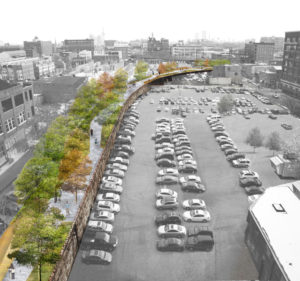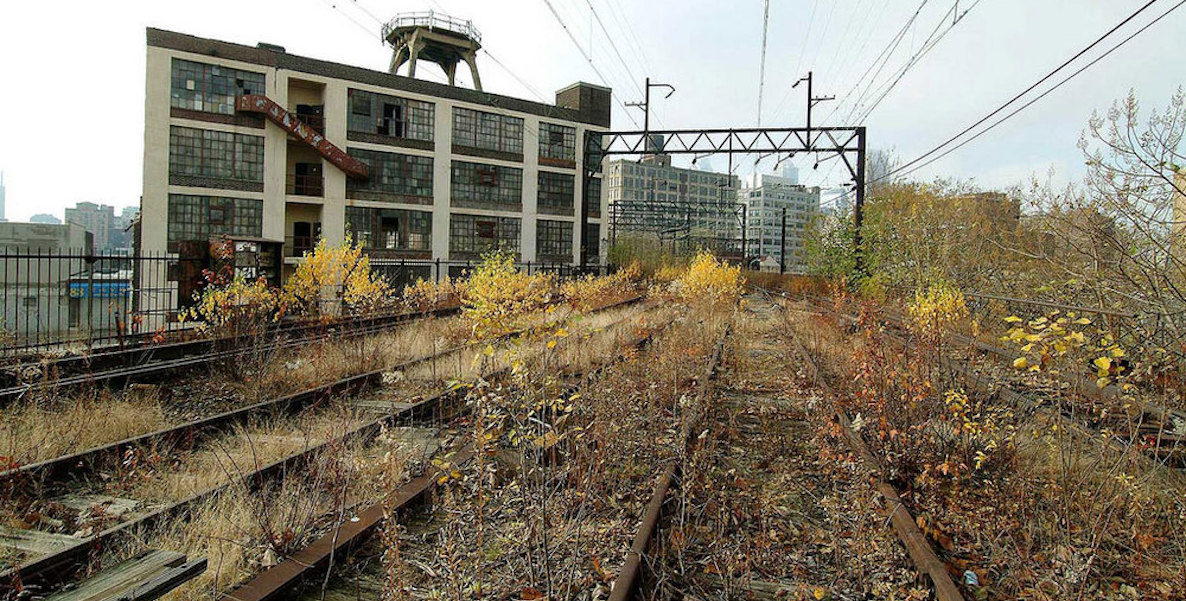Architect Bryan Hanes walks to an Apple desktop and pulls up a satellite view of the Callowhill/Chinatown North neighborhood.
“You can answer everything,” Hanes says, “through Google maps.”
He’s looking for a way to show the locations of land suitable for affordable housing around his much-anticipated Rail Park project. Renderings of the park hang on walls and are tucked into binders in his office, but none have the detail he needs. He needs serious zoom.
Focused on an extension of Chinatown known for its lofts and old warehouses, Hanes begins pointing at small, vacant parcels of land, mostly triangular in shape. One’s at 12th and Callowhill. Another’s at 11th and Noble. There’s about 10 in all. The slivers of land are likely not large enough to entice traditional developers looking to seize on the predicted popularity of the Rail Park, but Hanes and others involved with the Rail Park, such as the Center City District, have identified the tracts as ideal for affordable housing.
There’s a need for middle and low-income homes around the Rail Park, particularly given that immigrants and seniors in Chinatown are being pushed out by increasing rents. There’s plenty of room for growth north of Vine, east of Broad, yet new condos and lofts have been springing up for years, and average home prices in this area are four times higher than they were in 2000.
Projects like the Rail Park have the potential to transform sections of cities, making them more desirable and often less affordable. The High Line proved that. It’s also provided a warning for the Rail Park’s supporters to plan ahead for the inevitable changes to come.
Now the Rail Park is being thrown into the mix. Phase One, stretching for a quarter mile between 11th and Callowhill to Broad and Noble, is supposed to open this spring. The entire project, which has not been fully funded, would go from 9th and Spring Garden to 30th and Girard, tracing the old Reading Viaduct and resembling a giant check mark cutting through Brewerytown, Fairmount and Callowhill, with some portions elevated, like Phase One, and others underground.
The High Line is the inevitable comparison, but Hanes, Friends of the Rail Park and others involved don’t want a replica of the New York tourist hotspot. They say they want a Clark Park, a green space for a local community that right now barely has trees. To stay local, they’ve spoken to resident groups about inclusive programming, and they’ve identified those pieces of land for affordable housing.

But few projects have ever attracted more anticipation in Philadelphia, with many people and businesses expecting a transformative public space. As difficult as it’s been to secure funding for and plan a park atop a neglected rail line, the harder part could be benefiting and growing a diverse local population around it, particularly before developers fall in love with the finished product.
These parks have the potential to transform sections of cities, making them more desirable and often less affordable. The High Line proved that. It’s also provided a warning for the Rail Park’s supporters to plan ahead for the inevitable changes to come.
“I think the project has captured the imagination of a lot of people,” says Hanes, a native Kansan whose portfolio includes Pier 68 and The Porch at 30th since starting his own landscape architecture firm here in 2008. “Not just in the city but beyond. But it’s not the intent of this project for me to look out the window and see a group of German tourists up there packing it shoulder to shoulder every day of the week.”

In 2009, as the High Line was completed, co-founders Robert Hammond and Joshua David had a modest goal, not unlike Hanes and Friends of the Rail Park have in Philadelphia now: They lived in Chelsea and bemoaned its lack of a park. They wanted a green space for their neighborhood, which included two public housing residences, expecting the High Line to fill the need.
They got something far greater. The High Line became one of the biggest economic development engines in recent Manhattan history, leading to $2 billion in investment after five years and annual increases of $100 million in property taxes.
Few of the benefits, however, filtered toward the actual neighborhood—not even the green space. Annual visitors totaled about 7.6 million in 2015, and 69 percent of them weren’t even New Yorkers. Only 34 percent were people of color and that number was nearly twice as high as the High Line saw in earlier years after efforts to increase diversity. In 2011, Friends of the High Line spoke with low-income Chelsea residents who felt the park wasn’t for them, a meeting that helped lead toward the formation of the High Line Network.
The High Line Network (HLN) has hosted sharing sessions with 18 other cities planning elevated park projects, including Philadelphia. Paul Levy, executive director of the Center City District, has attended two HLN summits and members of Friends of the Rail Park another. The priority has been discussing how to thrive where the High Line failed, how to balance widespread popularity and expectations while providing local benefits.
The allure of these parks, as well as their funding strategies, make that goal difficult. The first phase of the Rail Park cost $10 million. The entire park will probably cost somewhere around $50 million. Private investors and state and local authorities fund expensive park projects expecting a return on investment, whether that’s development opportunities or increased taxes.
![]()
“One of the main reasons these are getting built is economic value for cities,” says Emma Bloomfield, director of the High Line Network. “That value is not always distributed evenly and certainly not among the neighboring community members, especially if those communities are more disadvantaged and don’t historically have a voice.”
It goes without saying these concerns are not on the minds of most developers. As a VP for a Washington-based company that invested in an apartment complex along the path of the Rail Park told the Inquirer in 2015, “If this can become High Line-esque, it’s nothing but upside.”
Even Governor Tom Wolf, attending the Rail Park’s groundbreaking ceremony in 2016, said, “Economic development has sprouted up all along the High Line and started with a lot less than what we started with here.”
With the potential for tourists and increased revitalization, Philadelphia will experience plenty of economic development. But the city can also use the Rail Park as an opportunity to balance growth with the needs of the middle class residents and immigrants who’ve already been moving into the area.

For Chinatown, the prospect of having an elevated park cut through the neighborhood didn’t sound much different than having the Vine Street Expressway do the same. The Philadelphia Chinatown Development Corporation opposed the Rail Park when plans began formalizing a few years ago. Callowhill/Chinatown North’s need for green space didn’t outweigh its need for affordability.
“We said five or six years ago that our biggest concern was how do people with lesser means remain in the neighborhood,” says John Chin, executive director of the Philadelphia Chinatown Development Corporation (PCDC). “That was a concern then, and it’s a concern today.”
![]() As Chinatown south of Vine becomes less affordable and its immigrant population declines, Callowhill/Chinatown North has been a refuge. Immigrants represent just over a fourth of the population in the area, an increase from about 500 in 2010 to 800 in 2016, according to Census data. The Callowhill/Chinatown North neighborhood grew in population overall from 2,000 to 3,000 between 2010 and 2016. Residents are 40 percent white, 22 percent black, 20 percent Asian and 12 percent Hispanic.
As Chinatown south of Vine becomes less affordable and its immigrant population declines, Callowhill/Chinatown North has been a refuge. Immigrants represent just over a fourth of the population in the area, an increase from about 500 in 2010 to 800 in 2016, according to Census data. The Callowhill/Chinatown North neighborhood grew in population overall from 2,000 to 3,000 between 2010 and 2016. Residents are 40 percent white, 22 percent black, 20 percent Asian and 12 percent Hispanic.
PCDC’s opposition contrasted with the Callowhill Neighbors Association. Sarah McEneaney, the group’s board president, is also board vice chair of Friends of the Rail Park and has been instrumental in bringing the park to fruition. She says “we are very aware” of the need to include programming geared at inviting the diverse communities of the neighborhood. The PCDC wants tai chi classes, space for chess and mahjong and opportunities for school children.
“There have been promises,” Chin adds, “our Philadelphia Rail Park will never be like the High Line.”
Paul Levy, executive director of the Center City District, has attended two High Line Network summits. The priority has been discussing how to thrive where the High Line failed, how to balance widespread popularity and expectations while providing local benefits.
He was made aware of the triangular parcels of land by the Center City District and says, “we would love to look at it.” Most of the parcels are owned by the Reading Corporation, the same company that owns much of the northern stretch of the proposed park, from 11th and Callowhill to 9th and Spring Garden. But the Center City District enlisted the help of architectural firm Cecil Baker to study those sites for affordable housing years ago. No formal plans to seize the land have been initiated. The discussions have been informal.
Chin says efforts from many organizations beyond PCDC would be needed for taking action. Funding—as with any affordable housing—will be an issue. PCDC’s most recent major development, a community center and housing complex north of Vine called Eastern Tower, cost $76 million and took years of wrangling state and local grants and credits. Affordable housing on these sites could collectively approach the cost of the entire Rail Park.
In Washington, D.C., a similar project, 11th Street Bridge Park, is in the works. Construction isn’t planned until 2019. The park’s budget is $55 million. But organizers have already secured an additional $65 million in funding for affordable housing opportunities and other avenues toward equitable development. They hired longtime community leader Vaughn Perry to work full time as equitable development manager.
“Ultimately whether the bridge park is ever built,” Perry says, “it’s still our belief that it’s important to make these investments.”
![]() Philadelphia isn’t the same as Washington or New York. That’s bad when it comes to seeking private funding from deep-pocketed donors for the park or for affordable housing around the park. It could be good for the timing of future development. Levy doesn’t anticipate a rush of new condo buildings and boutiques opening in Callowhill/Chinatown North like they did in Chelsea, at least not right away. “Therefore it gives us the time to plan for equitable development in the surrounding area,” he says.
Philadelphia isn’t the same as Washington or New York. That’s bad when it comes to seeking private funding from deep-pocketed donors for the park or for affordable housing around the park. It could be good for the timing of future development. Levy doesn’t anticipate a rush of new condo buildings and boutiques opening in Callowhill/Chinatown North like they did in Chelsea, at least not right away. “Therefore it gives us the time to plan for equitable development in the surrounding area,” he says.
But Hanes warns not to wait long to capitalize on affordable housing by the Rail Park. Parks look great on renderings, but when they’re completed they look even better. And they make everything else in the neighborhood look better, too, even tiny parcels of land.
“We learned from the High Line, development just gloms right onto the structure,” Hanes says. “Being right on the Viaduct will become more attractive to developers as it becomes a park. The sooner they can gain control of those parcels the better.”
Photo Courtesy of Studio Bryan Hanes




